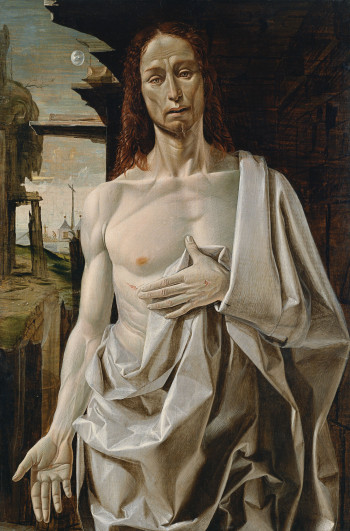Neither Google nor Bing show a results count when you search images (why not?), but it’s obvious that the number of Christian images of the Resurrection, especially of serious works of art, is enormously less than the number of images of the Cruxifixion. This is to some extent a reflection of the technical difficulty: if a painter can’t make a Cruxifixion affecting, he’s in the wrong business; a convincing Resurrection is hugely difficult. But religious artists basically respond to commissions, and the ratio reflects the unease of Christians with the idea. It was there in the proto-Church, see 1 Corinthians 15:12:
How can some of you say that there is no resurrection of the dead?
And if Christians are honest, it’s still a hard sell.
It is not then surprising that good Resurrection art is scarce. The works are often the work of oddball artists: Grünewald, whose day job was as a millwright; Piero della Francesca, day job mathematician; and the anonymous painter of the Chora in Istanbul (image, discussion).
Continuing our little RBC series of Easter artworks, here is one by Bramantino (who he?) in the Thyssen-Bornemisza in Madrid, dated to around 1490. Hi-res version on their website.
Bramantino takes the unease into outright shock and weirdness. It starts with the corpse-like pallor of the skin and the knife-like folds of the drapery: this isn’t fun. The most striking thing is the face: a head-on gaze, without joy or triumph, but inward-looking rather than judgemental. There is no glory here, and much recollected pain in the twisted mouth and bloodshot eyes. Victory no doubt, but that of a soldier who has survived a bloody battle; a Malplaquet, with no ringing of church bells in celebration.
The take is I suppose orthodox theologically. In the standard Christian theodicy, God became Isaiah’s suffering servant in the Passion, and suffers still through the ongoing sins of men and women. The eccentricity is in Bramantino’s omission of the joy of reunion, the humour, and the empathy we find in the Gospel accounts of the appearances, and the eschatological hope and triumph emphasised by the other artists in our series. Also in the lovely 8th-century Easter hymn by St. John of Damascus (take note of the hapless mediaeval geography, Ted Cruz):
The round earth keep high triumph, and all that is therein.
Enjoy your Easter eggs or chocolate bunnies, everybody.

johnarkansawyer says
That is a remarkable painting which has somehow escaped me till today-thank you for this! It looks so twentieth-century to my admittedly naive eye.
On a related subject, have you read Saving Paradise: How Christianity Traded Love of This World for Crucifixion and Empire? Its genesis-well, I'll quote the promo copy:
It's a remarkable book. How remarkable? This atheist found himself crying, several times, on reading the beauty of the Christianity they portray.
JamesWimberley says
Thank you for the pointer, especially as it goes against my thesis of iconographic rarity.
NCGatSmFcts says
I could very well be wrong about this, since I have not studied it and thus this is only based on my actual churchgoing experiences in Southern California (and I only remember even partially since the 70s - so this can't count as even a survey). But I also notice that there does not seem to be nearly as much good Easter music as Christmas music. Again though, I am pretty ignorant about musical history, I'm sorry to say.
JamesWimberley says
Well, there's the Hallelujah Chorus, and a few fine hymns. Not much to set against the great Passions of Bach and Schütz, but not trivial. What seems to be lacking entirely is popular and folk music that can compare with Christmas.
NCGatSmFcts says
Oooh, thanks for the list! My musical education is sadly lacking … me and most other Americans' I think. The "house band" at Sts. Simon and Jude in Huntington really brought it on Sunday — brass section and everything!!! It was lovely. Yet I only recognized one (non Easter) song. And if it's possible, I know even less about classical. Anyhoo. Maybe with all these talent shows on the telly, some of the history will be newly valued.
NCGatSmFcts says
Oh, and I liked the song you linked to, as well. It even stuck in my head for a while, which is interesting since it had such a restrained melody, imho. So, thanks again.